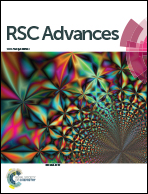Colorimetric detection of glutathione based on transverse overgrowth of high aspect ratio gold nanorods investigated by MCR-ALS†
Abstract
In this paper, we present a simple platform for colorimetric detection of glutathione using gold nanorods (AR ∼ 6.5 ± 0.2) as a plasmonic sensor. The functional mechanism of the sensor is based on shifts of longitudinal plasmon resonance during selective transverse overgrowth induced by preferential binding of glutathione at the nanorod tips. Under the optimum conditions, a calibration curve showed two linear regimes at the range of 50 nM to 20 μM of glutathione with a detection limit as low as 40 nM. The nanosensor maintains relatively high selectivity for determination of glutathione in the presence of several other amino acids. However, cysteine at similar concentration levels strongly competes with glutathione for available binding sites, thereby interfering in the determination of glutathione. We employed multivariate curve resolution-alternating least square (MCR-ALS) to track the morphology variation of the nanorods and elucidate the kinetics of the overgrowth process in the presence of glutathione and cysteine.


 Please wait while we load your content...
Please wait while we load your content...